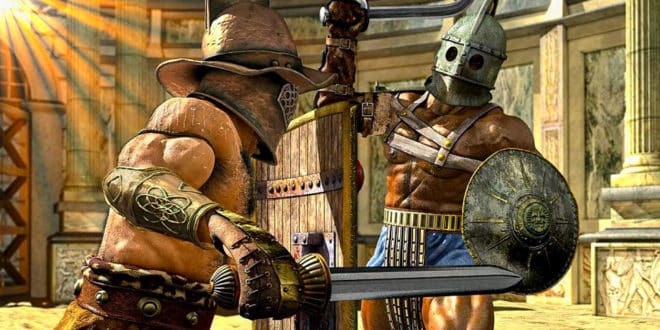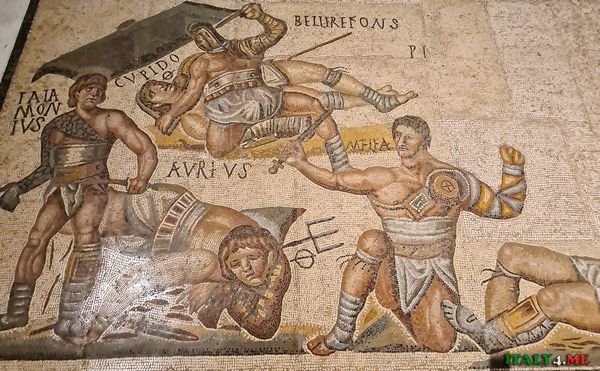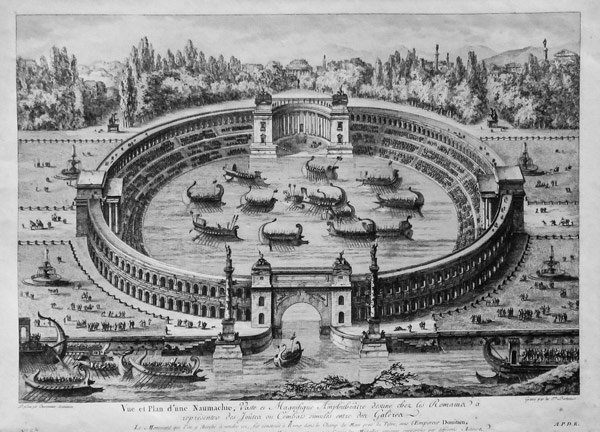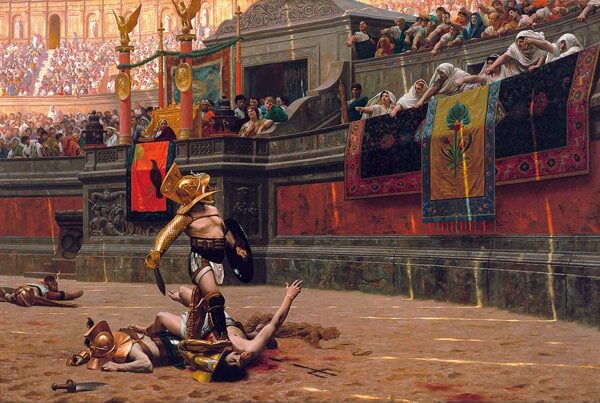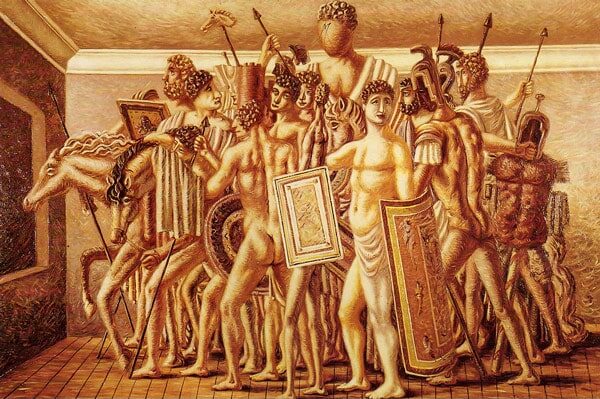Gladiator Games in Ancient Rome has always evoked a variety of emotions among contemporaries and researchers. Those who fought in the arena were simultaneously loved, despised, and feared.
The bloodshed in these battles stirred excitement, often eliciting admiration for the skill and conduct of the gladiators. Even women eagerly observed the outcome of these battles.
Page Contents
History
Over a thousand and a half years have passed since the world bid farewell to the Roman Empire, which was once the greatest state. Nevertheless, humanity still remembers the Romans’ love for bloody and cruel entertainment. We are talking about gladiatorial combat, a favored spectacle of every citizen of the empire.
The Origins of Gladiator Games
It is currently difficult to ascertain with certainty when and why gladiatorial combat originated.
According to one theory, based on the writings of the Greek historian Nicolaus of Damascus, it is believed that they emerged in Etruria and were part of funeral rites.
Subsequently, this theory found confirmation. Archaeological excavations were carried out in the city of Tarquinia, which is considered one of the oldest settlements of the Etruscans. Researchers discovered depictions of funerals, and one of the scenes depicted games that served as a prototype for gladiatorial combat.
Very quickly, these games transformed from funeral rites accompanied by sacrifices into public entertainment spectacles.
Several decades later, in 216 BCE, the ritual was repeated, this time in memory of the consul Marcus Aemilius Lepidus. The scale of the event was more significant, with three days of battles involving 22 pairs of fighters.
The next politician to be bestowed with such a great honor was Publius Licinius Crassus, who passed away in 183 BCE. The funerary ceremonies were marked by games in which 120 gladiators fought.
Gradually, this custom became so entrenched among the Romans that chroniclers did not even mention these “minor” fights.
Why Did Gladiatorial Combat Become Popular?
The public’s interest in this bloody spectacle grew rapidly, and it became such an integral part of Roman life that in 105 BCE, Rome received an offer from consuls to fund the fights from the treasury. The very first battles featuring trained gladiators funded by the state gained incredible popularity, quickly becoming public events.
The famous slogan “Bread and circuses!” has reached our days. It holds the secret to the popularity of gladiatorial combat. The common Romans were well acquainted with poverty. Throughout their lives, they struggled with hunger, and the emperor, well aware of the dangers of a desperate populace, thus bestowed this spectacle as a gift to his people.
Peak of Popularity
The performances of gladiators gradually reached the peak of popularity, becoming a beloved pastime of both the aristocracy and the common people. It was no longer just fights; it was a true show designed to captivate the audience’s imagination.
People learned about upcoming celebrations by reading announcements posted on special boards. They provided all the necessary information: the date, time, occasion, number of fighters, names of the most famous gladiators, and the order of performances.
The night before the fight, the future participants would spend in feasts. Exquisite delicacies were ordered for them, musicians played, and beautiful women danced.
In the morning, the city residents marveled at the solemn procession of the gladiators. Lictors walked before them, followed by trumpeters and their entourage. At the end of the procession, there was a scribe and a person holding a palm branch, which would be used to bestow honors upon the victor.
Try to mentally transport yourself to the spectator stands and feel the atmosphere of this bloody spectacle. So, the action begins.
First, wild animals are released into the arena — lions, tigers, bears, which have been deprived of food for several days to make them more ferocious. It’s no wonder that a real battle immediately ensues. Another option is a beast hunt. A special gladiator, called a “venator,” confronts the animals. Instead of armor, he wears a few leather strips, and his only means of defense is a spear.
Next, the audience is presented with another spectacle — the execution of criminals or Christians, who are unarmed and sent out to be torn apart by hungry and ferocious animals.
Such a death was a great humiliation in the eyes of every Roman. But this part of the performance is over, the bodies of the deceased are removed from the arena with hooks, and the bloody stains are covered with fresh sand.
The main characters — the gladiators — appear before the spectators. They are currently armed with wooden swords, ensuring that no one will die in the ensuing battle. This fight is a warm-up of sorts, preparing the fighters and the audience. Special attendants, known as “lanistae,” introduce the participants of the matches to the public.
The battles were kept relatively short to avoid boredom. Only 10-15 minutes, and the outcome is evident. The signal for the start of the fight was a sound produced by a horn. Throughout the day, visitors could witness no more than 10-13 fights.
Gladiators were required to follow certain rules, which were enforced by judges called “summa rudis.” Usually, retired gladiators were appointed to this position, and their judgments were unquestionably accepted.
The defeated but still alive warrior would turn to the judge, acknowledging his defeat, and raise three fingers upwards – the thumb, index, and middle fingers. Now his fate depended on the desires of the crowd. A gladiator who had earned respect through his skill, bravery, and fighting abilities could hope for mercy. However, if mercy was denied, he would have to undergo another trial — to die, facing his opponent without losing his dignity.
The victor received a laurel wreath and money. If a gladiator was a condemned criminal or a slave, they could be rewarded with the highest honor — a wooden sword symbolizing freedom.
Julius Caesar achieved particular success in organizing the games, elevating them to an art form by incorporating elements of theater. For example, impressive stage sets were erected on the arena in a short period of time, replicating the walls of Carthage. The first group of gladiators would portray legionaries, while the second group represented Carthaginians.
Another surviving account states that the gladiatorial combat took place amidst freshly felled trees representing a forest, recreating the battle between Roman legionnaires and Germans.
Navalia – Naval Battles
For the ruler, nothing was impossible, and the most fantastical scenarios were always brought to life. For example, even staged naval battles, called “navalia” or “naumachia,” were organized.
In 46 BCE, the city’s inhabitants knew they were in for an unprecedented spectacle. A massive artificial lake was excavated in the Campus Martius. Sixteen galleys clashed in a fierce battle, propelled by 4,000 rowers, while 2,000 gladiators spilled each other’s blood.
It seemed impossible to stage more impressive games, but 44 years later, Augustus Caesar delighted the Romans with a naumachia featuring 24 ships and 3,000 warriors. The city’s residents had the opportunity to witness the Battle of Salamis firsthand—a naval conflict between the Greek and Persian fleets that occurred in 480 BCE.
Emperor Claudius surpassed this record. The event took place on Lake Fucino, where 50 ships met in a desperate battle, carrying 20,000 people. The spectators were ecstatic at the spectacle.
Gladiatorial combat was the favorite spectacle of the Romans. It provided people with intense emotions and excitement and bolstered their sense of patriotism. The fighters were often dressed and armed as representatives of conquered nations. The battles repeatedly showcased the might of the Roman Empire.
The Prohibition of Gladiator Fights
Over time, the state entered a period of crisis. Invasions by enemies intensified, a devastating epidemic of the plague broke out, and economic decline and the Civil War took their toll. Christianity spread more and more, and many prominent individuals began to embrace this religion. As a result, the popularity of gladiatorial combat gradually waned.
The first attempt to ban these fights was made in 315 AD. Emperor Constantine I prohibited the offering of people to be torn apart by animals in the arenas.
In 365 AD, another emperor, Valentinian I, introduced penalties for judges who continued to issue such sentences for Christians.
In the late 4th to early 5th century AD, Emperor Honorius closed down the schools where gladiators were trained.
In 438 AD, Valentinian III once again imposed a ban on gladiatorial games, and a year later, historians mention the last games in Rome.
The Venues Where the Fights Took Place
The first battles took place in open spaces in the city markets. To ensure that prominent individuals could enjoy the spectacle with all the comforts, temporary structures were erected on elevated areas. As the fights gained increasing popularity, special venues were required.
Initially, amphitheaters were made of wood. A stone structure was erected in Rome in 29 BC. Pliny mentions that it could accommodate about 80,000 spectators and had three levels adorned with statues and decorated with marble. However, 35 years later, a fire destroyed this amphitheater because it was built on a wooden framework.
Amphitheater
In 80 AD, the Roman people received a truly imperial gift. Titus Flavius Vespasian built an amphitheater, the remains of which we can still see today – the Colosseum (Colosseo).
This magnificent structure was a marvel of engineering.
Special attention was given to the comfort of the spectators – upon entry, they had the opportunity to buy various souvenirs, and dedicated staff helped them find their seats. The aristocracy observed the battles comfortably seated in the shaded grandstands. The commoners, on the other hand, were positioned higher up and stood throughout the performances.
The corridors leading to the grandstands bustled with activity. Numerous vendors praised their goods, offering various delicacies and lists of gladiators. Excited crowds gathered, anticipating the upcoming battles.
The Spectators
The front rows were occupied by the most privileged individuals. There were seats for senators, members of noble families, and soldiers. During the reign of Augustus, women watched the fights from specially designated areas.
Famous gladiators were well-known to the public. Many spectators had their favorites and cheered for them enthusiastically. Moreover, at the request of the crowd, victorious gladiators could be rewarded with their freedom. Bets were placed on the outcome of the battles, and fortunes were won or lost.
For example, a well-documented fight between two popular gladiators, Verus and Priscus, is widely known. Each of them had their own fan base, and the excitement of the audience was heightened by the fact that the warriors were best friends.
Culture of Gladiator Fights
Such a significant phenomenon could not go unnoticed in the realm of culture. Many artists drew inspiration from gladiatorial battles.
Paintings
In 1872, the French artist Jean-Léon Gérôme immortalized a tragic moment in his painting “Pollice verso,” which translates from Latin as “with a turned thumb.”
The painting captures the range of emotions – the anticipation of the victor, the unanimous verdict of the impassioned crowd, and the doomed fate of the defeated, acknowledging their defeat. The masterpiece is now housed in the Phoenix Art Museum (phxart.org) in Arizona.
Italian artist Giorgio de Chirico dedicated an entire cycle of works to gladiators.
In 2008, Andrei Shishkin created an impressive portrait titled “Gladiator.”
In Music
The band “Aria,” known for its repertoire of historical-themed hits, also delved into the era of Ancient Rome.
Their song “Colosseum,” released in 2002, vividly tells the story of a prisoner who becomes a gladiator. The lyrics, written by Alexander Yelin, skillfully convey the protagonist’s emotions and the atmosphere of the battles.
Top 5 Gladiator Movies
The gladiatorial games have found significant representation in the world of cinema. Directors and actors have depicted the fights on screen with maximum authenticity, imbuing them with tragedy and emotion.
- “Gladiator” – a feature film directed by Ridley Scott (USA, 2000). The story revolves around Maximus, a noble warrior and general. Betrayed and thrown into the Colosseum, he faces a battle with an old enemy.
- “Spartacus: Blood and Sand” – a TV series directed by Steven S. DeKnight (USA, 2010). The series tells the lesser-known early years of Spartacus, showcasing the personal tragedy of the main character, his incredible courage, and fame.
- “The Fall of the Roman Empire” – a film directed by Anthony Mann (USA, 1964). The film presents the era of the empire’s decline. Threats of invasion, crises, waning popularity of gladiatorial games, and intrigues together create a captivating narrative.
- “Demetrius and the Gladiators” – a film directed by Delmer Daves (USA, 1954). It tells the incredible story of a Christian who becomes a gladiator due to a series of circumstances. Will his faith withstand the upcoming trial in the arena?
- “The Two Gladiators” – a film directed by Mario Caiano (Italy, 1964). The unexpected appearance of another claimant to the throne puts the emperor in a difficult position. A deadly duel will determine who will rule.
The interest in this chapter of history remains unabated. Numerous researchers continue to study the discovered historical sources, sharing their findings with the world.
Mentally step onto the arena of the Colosseum, or better yet, buy tickets and close your eyes. Listen carefully, immerse yourself as a participant in the events that echoed centuries ago. Can you hear the roar of the crowd, the sounds of footsteps, the music muffled by the clashing of weapons? Such was the voice of the Eternal City. Ave, Caesar, morituri te salutant!
Interesting Facts about Gladiator Fights
- Gladiator fights, known as munera, were a popular form of entertainment in Ancient Rome, captivating audiences with thrilling displays of combat and skill.
- The earliest recorded gladiator fights date back to 264 BC when Decimus Junius Brutus celebrated his deceased father’s funeral with three pairs of gladiators in Rome.
- Gladiators came from diverse backgrounds and were often slaves, prisoners of war, or condemned criminals. Some volunteers, known as auctorati, also fought as gladiators.
- The most renowned gladiatorial training school, the Ludus Magnus, was established in Rome in the 1st century BC by the emperor Domitian. It produced some of the greatest gladiators of the time.
- The Colosseum, completed in 80 AD, was a magnificent venue for gladiator fights. It could hold up to 50,000 spectators and featured elaborate stage sets, trapdoors, and even artificial lakes for naval battles.
- Gladiators fought with various weapons, including swords, tridents, nets, and shields. Each weapon had its own unique style and techniques, adding to the excitement and variety of the battles.
- Gladiatorial games reached their peak during the reign of Emperor Commodus (180-192 AD), who personally participated in fights, often defeating opponents with staged outcomes. His reign marked a decline in the authenticity and honor of gladiator contests.
 Italy for me From Italy with love
Italy for me From Italy with love

